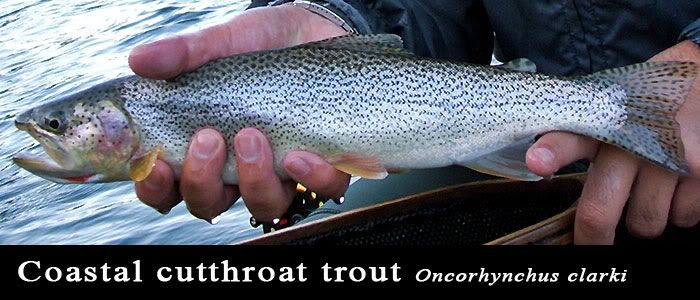This thread should have been started earlier.


Between early December and late April, the Chilliwack River offers a productive winter steelhead fishery for both local and visiting anglers around the Fraser Valley and Lower Mainland. While other nearby systems also provide such a fishery, the Chilliwack River yields more success due to the amount of fish being produced by the Chilliwack River Hatchery. This thread has several objectives:
- To provide valuable information such as fishing techniques, regulations, fish identification and other related information for first-time anglers who wish to participate.
- To provide updated river conditions such as water clarity and level for all anglers.
Fishing regulationsRegulations for the steelhead fishery differ slightly to the fall salmon fisheries in BC, so please familiarize by going through the
BC Freshwater Fishing Regulation Synopsis from time to time if unsure. For the Chilliwack River, anglers should be aware of these regulations. Please report violators by phoning 1-877-952-RAPP (7277).
- You must have a valid freshwater angling licence. You must purchase a steelhead conservation surcharge if you wish to fish for steelhead (even if you only intend to catch and release). Freshwater angling licence and conservation surcharges can now be purchased online.
- The daily quota of steelhead is one hatchery marked fish, which can be identified by the absence of the adipose fin and the presence of a healed scar. Once you retain your hatchery steelhead, you must stop fishing for the day and mark your catch on your licence immediately.
- All wild steelhead must be released with care by keeping the fish in the water at all time.
- All chinook salmon must be released between January 1st and May 31st. Anglers may encounter early chinook salmon occasionally in the winter steelhead fishery, so please be aware of the differences between a chinook salmon and a steelhead.
- The river section above the Vedder Crossing is closed from May 1st to June 30th.
- The river section below the Vedder Crossing is only opened to flyfishing from May 1st to 31st and closed from June 1st to 30th.
Fish species and identificationsWhile the primary target species is steelhead in this fishery, several other species may also be encountered. It is important to know the morphological differences between these species so you do not accidentally retain a fish that is not opened for retention.

Steelhead's life history is similar to pacific salmon's. It is a variation of rainbow trout, which has an ocean phase. Unlike pacific salmon, steelhead may not die after spawning. Size range of steelhead from the Chilliwack River ranges between 6lb and 15lb, while bigger fish have often been recorded every season.
Several identification keys can be used to recognize a steelhead. Its white gum and tongue, lack of teeth behind the tongue. Once arrived from the ocean, its body is silver with heavily spotted back. Its tail is spotted from top to bottom and it is not forked. During spawning phase, pink and red colourations become apparent on the gill plates and across the body. Below are additional photos that may assist you.




Resident rainbow trout can also be caught while targeting steelhead. Unlike steelhead, they are typically under 18 inches in length or 2lb in weight. All wild rainbow trout must be released.

Bull trout are often encountered while targeting steelhead and they are required to be released. Their size ranges between 1lb and 10lb. Bull trout can easily be identified by its white and pink spots across the body. Their mouth is large and extends way behind the eyes. The end of their pelvic fins is often white. All bull trout must be released.

Coastal cutthroat trout travel in schools. Several identification keys can be used to differentiate them from rainbow trout. Their body and tail are heavily spotted from top to bottom. An orange slack can be found on the bottom side of the gill plate. Their size typically ranges between 8 and 20 inches. Only hatchery cutthroat trout can be kept. All wild cutthroat trout must be released.

Mountain whitefish belong in the salmonid family. While their body is similar to a minnow, one can easily identify them by locating the adipose fin. Their mouth is small and protudes slightly. Their size typically ranges between 8 and 20 inches.
General etiquettesWhen fishing for steelhead in a stream, it is considered rude to start just downstream from another angler who is already fishing. When approaching a run, always start from the head of it and work your way down so other anglers can have a chance to try it too. If other anglers are already fishing at a spot where you want to fish, then you should either move to a different spot or talk to them first. More likely than not, other anglers do not mind having you joining them.
2012 steelhead brood collection programInformation to come.
Additional readingsAdditional video clipsThe following steelhead instructional series are available for
our subscribers.
Steelhead Basics (21 minutes 55 seconds)In this instructional series, seasoned Chilliwack angler Nick Basok from Chilliwack Dart and Tackle explains what type of gear you need when targeting Vedder winter steelhead.
Hunting for Late Season Steels (11 minutes 47 seconds)Episode five of 2010's video diary features a late season steelhead fishing trip on a very warm April day. Nick Basok and Chris Gadsden, two experienced Chilliwack River anglers, search for the most prized freshwater gamefish in British Columbia, Canada.
Additional helpYour local tackle stores in the Lower Mainland and Fraser Valley provide excellent additional resource.

 Author
Topic: 2011/12 Chilliwack River steelhead fishery information & water condition updates (Read 327514 times)
Author
Topic: 2011/12 Chilliwack River steelhead fishery information & water condition updates (Read 327514 times)

